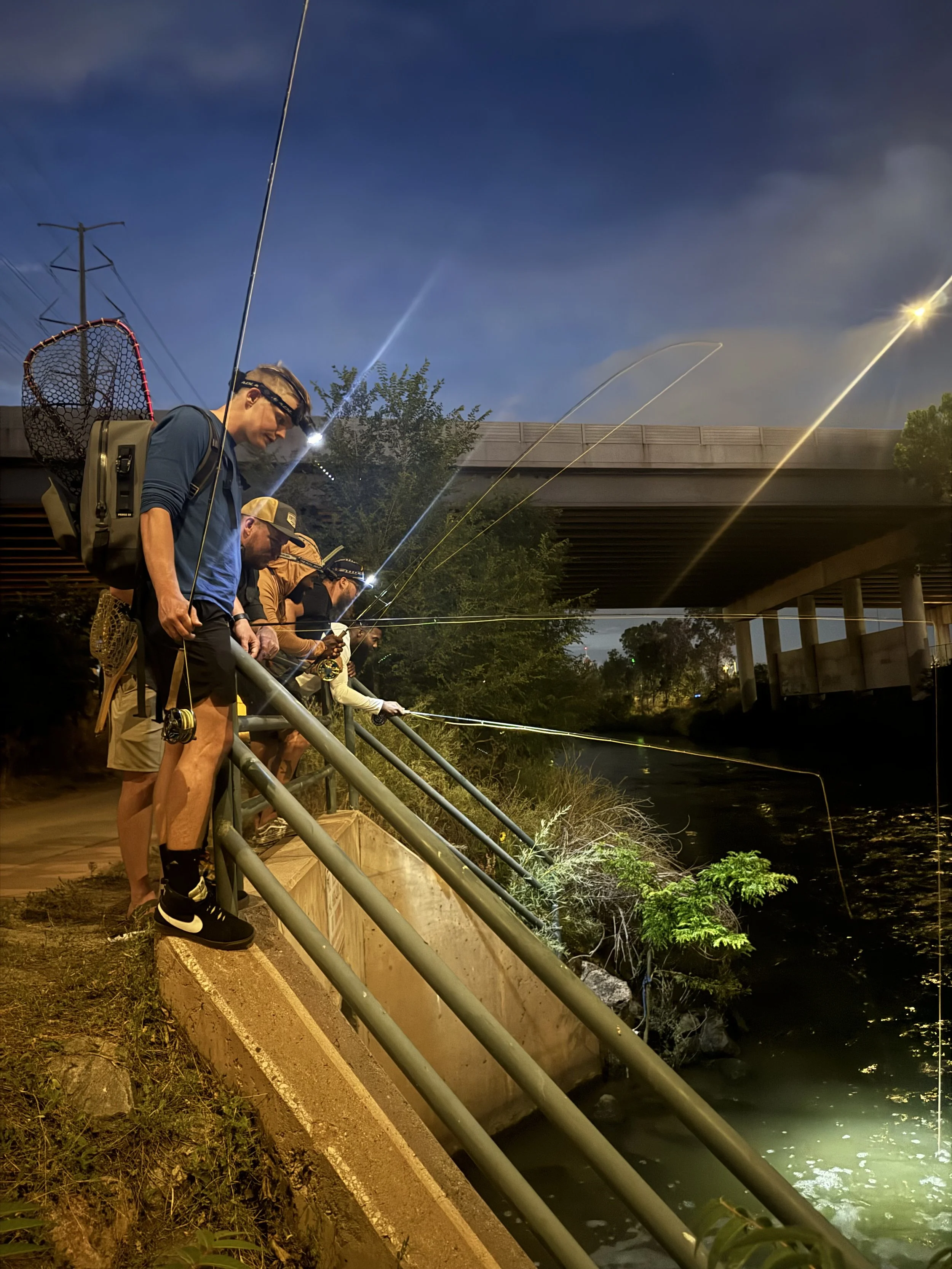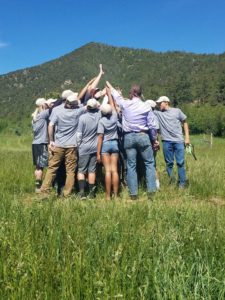Colorado Parks and Wildlife press release GUNNISON, Colo. – Inside Colorado Parks and Wildlife’s Roaring Judy Hatchery, the staff is working to save and breed 158 unique cutthroat trout rescued from Hayden Creek during last year’s devastating Hayden Pass wildfire, southwest of Cañon City.
Throughout June, hatchery technicians have artificially extracted milt and roe – semen and eggs – from the unique cutthroat trout, which were first discovered in Hayden Creek by CPW biologists in 1996. Today they may be the last survivors because no fish were found in an initial survey of the South Prong of Hayden Creek in the aftermath of the wildfire and subsequent flooding.
The fire erupted from a lightning strike last July 8 and roared out of control for weeks, eventually charring 16,754 acres across the Hayden Creek and Big Cottonwood Creek drainages above the Arkansas River near Coaldale.
At the time, CPW staff and U.S. Forest Service (USFS) volunteers made a desperate dash behind the fire lines and captured roughly half of the cutthroats believed to be living in a one-mile stretch of the South Prong.
Of the rescued trout,158 were taken to Roaring Judy and placed in isolation. The other 36 were released in Newlin Creek south of Cañon City with a goal that they would reproduce naturally.
Several hundred fish were left behind in hopes they would survive and the monsoon rains would spare the drainage. Heavy rain events after a fire can inundate streams with debris, ash and sediment making it difficult for fish to survive and reproduce.
Indeed, soon after the fire, fall monsoons ravaged the watershed. Biologists returned to the area with sampling gear and could not find a single fish. They plan to return to the creek this fall in hopes of finding a few hardy survivors .
The Hayden Creek cutthroat are unique and different than the famed pure greenback cutthroat residing in Bear Creek, on the western edge of Colorado Springs. Those trout, which ironically are native to the South Platte River basin, were once thought to be extinct in the 1930s. A study headed up by scientists at CU Boulder in 2012 revealed that the only true greenback cutthroat resided in Bear Creek. That information led to the propagation and eventual reintroduction of those fish into several streams and one lake in the South Platte basin.
The cutthroat trout in Hayden Creek, and now in the hatchery, are unique and contain genes matching museum specimens collected by early explorers. In 1889, ichthyologist David Starr Jordan collected a pair of trout specimens from Twin Lakes, near Leadville. Today those specimens reside at the Smithsonian Institution's National Museum of Natural History. The Hayden Creek cutthroat trout are the only known modern fish to share their genetics.
“The coordination that occurred between the USFS staff and CPW to rescue these fish from the wild during an active fire was truly amazing,” said Josh Nehring, CPW senior aquatic biologist. “Furthermore, our staff at Roaring Judy, lead by Seth Firestone, has provided exceptional care to these fish. It is not an easy task to take a wild fish into the hatchery and get them to survive let alone reproduce. Kudos to that team!”
Their spawning efforts began June 12 in the isolation unit located along the East River, north of Gunnison.
Firestone, hatchery manager, said roe was stripped from 10 female cutthroat and mixed with milt from 10 males the first day. Action continued June 19 and the staff is hopeful for more success the week of June 26.
But the rescue is not without risk. The trout are being treated for fungus attributed to male aggression.
“It’s a concern,” Firestone said, describing how the fish are receiving weekly baths in a mild saltwater solution to combat the fungus. “We are doing our best to keep it under control.”






 Monday was the first full day of camp and after waking up, the kids went to the stream and pond at the ranch to learn about the entomology of the watershed. The kids took bug samples to learn about what the fish would be eating in the area and took water samples to determine the health of the stream and pond. After the sampling, students ate lunch and headed to nearby North Lake to fish for the afternoon. It wasn't long before kids started hooking into fish and in the first day over half of the kids had landed their first fish of the camp and for some, their first fish ever.
Monday was the first full day of camp and after waking up, the kids went to the stream and pond at the ranch to learn about the entomology of the watershed. The kids took bug samples to learn about what the fish would be eating in the area and took water samples to determine the health of the stream and pond. After the sampling, students ate lunch and headed to nearby North Lake to fish for the afternoon. It wasn't long before kids started hooking into fish and in the first day over half of the kids had landed their first fish of the camp and for some, their first fish ever. Over the first few days the kids had free time to tie flies and practice their fly fishing skills and on Wednesday they had a chance to hone in those skills and use the flies they have tied. The day started off by traveling to North Lake for the morning. While at North Lake kids were catching fish left and right and by halfway through the morning, everyone had caught a fish. After returning to the camp, the kids ate lunch and broke up into teams of three for some additional fishing. One group headed to some beaver ponds, another group fished the stream, and the third group fished a lake on the ranch property.
Over the first few days the kids had free time to tie flies and practice their fly fishing skills and on Wednesday they had a chance to hone in those skills and use the flies they have tied. The day started off by traveling to North Lake for the morning. While at North Lake kids were catching fish left and right and by halfway through the morning, everyone had caught a fish. After returning to the camp, the kids ate lunch and broke up into teams of three for some additional fishing. One group headed to some beaver ponds, another group fished the stream, and the third group fished a lake on the ranch property. When the 15 campers arrived on June 11, there were nervous faces and uneasy feelings about what to expect for the upcoming week. But just a few days later on June 16 the campers had a hard time leaving one another. The friendships formed, the lessons learned, and the memories made will carry on forever and many students mentioned coming back in 2018.
When the 15 campers arrived on June 11, there were nervous faces and uneasy feelings about what to expect for the upcoming week. But just a few days later on June 16 the campers had a hard time leaving one another. The friendships formed, the lessons learned, and the memories made will carry on forever and many students mentioned coming back in 2018. This Spring, he graduated from Western State University in Gunnison majoring in Chemistry with an emphasis in Biochemistry. But he's leaving behind an incredible legacy of coldwater conservation leadership. In 2013, Adam founded The Gunnison Sockeyes, the first TU Costa Five Rivers collegiate club in the nation to found their club based on conservation rather than fly fishing. The club boasts over 160 members and has logged in excess of 220 man hours of service work in the Gunnison Watershed in the fields of Lake Trout Removal, Kokanee Salmon Spawning, Electroshocking, Stonefly Reintroduction and River Clean Ups.
This Spring, he graduated from Western State University in Gunnison majoring in Chemistry with an emphasis in Biochemistry. But he's leaving behind an incredible legacy of coldwater conservation leadership. In 2013, Adam founded The Gunnison Sockeyes, the first TU Costa Five Rivers collegiate club in the nation to found their club based on conservation rather than fly fishing. The club boasts over 160 members and has logged in excess of 220 man hours of service work in the Gunnison Watershed in the fields of Lake Trout Removal, Kokanee Salmon Spawning, Electroshocking, Stonefly Reintroduction and River Clean Ups. Growing up on the banks of the Mississippi and experiencing its periodic floods gave me no background for understanding the water scarcity issues of the west. When the mighty Miss and its tributaries flooded they used to let us older boys out of school and permit trustee crews from the state prison to help sandbag. It was usually a problem of too much water, so I was fascinated by the complexity of water law created by the scarcity of water and the mission of TU to conserve and correct the mistakes of the past just seemed to me to make manifest sense.
Growing up on the banks of the Mississippi and experiencing its periodic floods gave me no background for understanding the water scarcity issues of the west. When the mighty Miss and its tributaries flooded they used to let us older boys out of school and permit trustee crews from the state prison to help sandbag. It was usually a problem of too much water, so I was fascinated by the complexity of water law created by the scarcity of water and the mission of TU to conserve and correct the mistakes of the past just seemed to me to make manifest sense. My favorite fishing spot is any spot I happen to be in which harbors fish. I advocate carrying a flyrod in every vehicle because you never know when you will run into a fishing emergency! Although exotic locales beckon to many I have trouble getting too far away from my home rivers - and ponds. I flyrod a lot of local natural area ponds for warmwater species too. Also take a trip to Canada each June with a couple of RMF's founding fathers, but home waters are the preferred locales since they are close.
My favorite fishing spot is any spot I happen to be in which harbors fish. I advocate carrying a flyrod in every vehicle because you never know when you will run into a fishing emergency! Although exotic locales beckon to many I have trouble getting too far away from my home rivers - and ponds. I flyrod a lot of local natural area ponds for warmwater species too. Also take a trip to Canada each June with a couple of RMF's founding fathers, but home waters are the preferred locales since they are close. , paired with the direction of a dedicated college adviser (who happens to be a fisheries economist) shaped my undergraduate studies and kindled my focus in conservation.
, paired with the direction of a dedicated college adviser (who happens to be a fisheries economist) shaped my undergraduate studies and kindled my focus in conservation.











